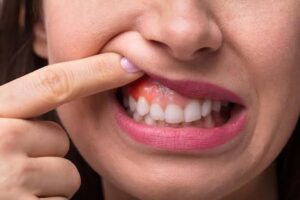
Gingival Disease in Pregnancy Gingival changes in pregnancy were described as early as 1898, even before any knowledge about hormonal changes in pregnancy was available. Pregnancy itself does not cause gingivitis. Gingivitis in pregnancy is caused by bacterial plaque, just as it is in nonpregnant women. Pregnancy accentuates the gingival response to plaque and modifies the resultant clinical picture
No notable changes occur in the gingiva during pregnancy in the absence of local factors.
The reported incidence of gingivitis in pregnancy in well-conducted studies varies from about 50% to 100% Pregnancy affects the severity of previously inflamed areas; it does not alter healthy gingiva. Impressions of increased incidence may be created by the aggravation of previously inflamed but unnoticed areas. Tooth mobility, pocket depth, and gingival fluid are also increased in pregnancy.”

The severity of gingivitis is increased during pregnancy beginning in the second or third month. Patients with slight chronic gingivitis that attracted no particular atten- tion before the pregnancy become aware of the gingiva because previously inflamed areas become enlarged, edematous, and more notably discolored. Patients with little or no noticeable gingival bleeding before pregnancy become concerned about an increased tendency to bleed .

Gingivitis becomes more severe by the eighth month and decreases during the ninth month of pregnancy; plaque accumulation follows a similar pattern. Some investigators report that the greatest severity is between the second and third trimesters. The correlation between gingivitis and the quantity of plaque is greater after parturition than during pregnancy, which suggests that pregnancy introduces other factors that aggravate the gingival response to local factors.
Partial reduction in the severity of gingivitis occurs by 2 months postpartum, and after 1 year the condition of the gingiva is comparable to that of patients who have not been pregnant.” However, the gingiva does not return to normal as long as local factors are present. Tooth mobility, pocket depth, and gingival fluid are also reduced after pregnancy. In a longitudinal investigation of the periodontal changes during pregnancy and for 15 months postpartum, no significant loss of attachment was observed.
Pronounced ease of bleeding is the most striking clini- cal feature. The gingiva is inflamed and varies in color from a bright red to bluish red. The marginal and interdental gingivae are edematous, pit on pressure, appear smooth and shiny, are soft and pliable, and sometimes present a raspberry-like appearance. The extreme redness results from marked vascularity, and there is an increased tendency to bleed. The gingival changes are usually painless unless complicated by acute infection. In some cases the inflamed gingiva forms
discrete “tumorlike” masses, referred to as pregnancy tumors .
Microscopically, gingival disease in pregnancy appears as nonspecific, vascularizing, proliferative inflamma- tion. Marked inflammatory cellular Infiltration occurs, with edema and degeneration of the gingival epithelium and connective tissue. The epithelium is hyperplastic, with accentuated rete pegs, reduced surface keratinization, and various degrees of intracellular and extracellular edema and infiltration by leukocytes. Newly formed engorged capillaries are present in abundance.
The possibility that bacterial-hormonal interactions may change the composition of plaque and lead to gingival inflammation has not been extensively explored. Kornman and Loesche reported that the subgingival flora changes to a more anaerobic flora as pregnancy progresses; the only microorganism that increases signifi- cantly during pregnancy is P. intermedia. This increase appears to be associated with elevations in systemic levels of estradiol and progesterone and to coincide with the peak in gingival bleeding. It has also been suggested that during pregnancy, a depression of the maternal T-lymphocyte response may be a factor in the altered tissue response to plaque.
The aggravation of gingivitis in pregnancy has been attributed principally to the increased levels of progester-one, which produce dilation and tortuosity of the gingival microvasculature, circulatory stasis, and increased susceptibility to mechanical irritation, all of which favor leakage of fluid into the perivascular tissues. A marked increase in estrogen and progesterone occurs during pregnancy, with a reduction after parturition. Animal studies with radioactive estradiol have demonstrated that the gingiva is a target organ for female sex hormones. The severity of gingivitis varies with the hormonal levels in pregnancy.
It has also been suggested that the accentuation of gingivitis in pregnancy occurs in two peaks: during the first trimester, when there is overproduction of gonado- tropins, and during the third trimester, when estrogen and progesterone levels are highest. Destruction of gingival mast cells by the increased sex hormones and the resultant release of histamine and proteolytic enzymes may also contribute to the exaggerated inflammatory response to local factors .
Clinical Management :
A thorough medical history is an imperative component of the periodontal examination, especially in the preg nant patient. Because of immunologic alterations, increased blood volume (ruling out mitral valve prolapse and heart murmurs), and fetal interactions, the clinician must diligently and consistently monitor the patient’s medical and periodontal stability. Medical history dialog should include pregnancy complications, previous mis- carriages, and recent history of cramping, spotting, or pernicious vomiting. The patient’s obstetrician should be contacted to discuss her medical status, periodontal or dental needs, and the proposed treatment plan.
Establishing a healthy oral environment and main- taining optimal oral hygiene levels are primary objectives in the pregnant patient. A preventive periodontal pro- gram consisting of nutritional counseling and rigorous plaque control measures in the dental office and at home should be reinforced.
Plaque Control :
The increased tendency for gingival inflammation during pregnancy should be clearly explained to the patient so that acceptable oral hygiene techniques may be taught, reinforced, and monitored throughout pregnancy. Scaling, polishing, and root planing may be performed whenever necessary during pregnancy. Some practitioners avoid the use of high- alcohol-content antimicrobial rinses in pregnant women and prefer to use non-alcohol-based oral rinses.
Prenatal Fluoride :
The prescribing of prenatal fluoride supplements has been an area of controversy. Although two studies have claimed beneficial results, others suggest that the clinical efficacy of prenatal fluoride supplements is uncertain, and that the mechanism by which prenatal fluorides might impart cariostasis is unclear.
The American Dental Association (ADA) does not re- commend the use of prenatal fluoride because its efficacy has not been demonstrated. The American Academy of Pediatric Dentistry supports this position as well. The American Academy of Pediatrics has no stated position on prescribing prenatal fluorides.